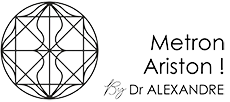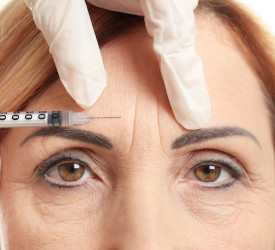
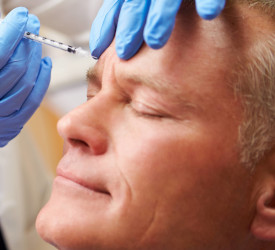
Botulinum Toxin
(Neuromodulators, Dysport)
The botulinic toxin is a substance which decreases the muscle contraction by acting at the level of the neuro-muscular junction (myorelaxing action). Since 1975, botulinic toxin has been used to correct child strabism, facial tics and spontaneous eye blinking. Concerning aesthetic medicine, it was first noticed that patients treated with botulinic toxin have less wrinkles around the eye than the others. In 1990, a more observing female patient asked her doctor to balance the other eye: the aesthetical indication was thus born. In 2002, the botulinic toxin, received, in the USA, the Food and Drug Administration (FDA) authorization for its use to treat the wrinkles in between the two eyebrows.
The more usual indications for botulinic toxin aesthetical injections are the wrinkles between the two eyebrows, the frontal lines and the crow-feet wrinkles. The principle of botulinic toxin consists of using its muscular release properties. The main goal, we want to reach, is to obtain a decreased muscular action at the level of the forehead and the eyebrows, in order to decrease the horizontal and/or vertical wrinkles induced by muscle contraction.
The brow position is actually fixed by the balance of two opposite forces, one corresponding to lowering muscles (located around the eyebrow) and the other one corresponding to one elevating muscle (the frontalis muscle).
The horizontal wrinkles are due to the contraction of the frontalis muscle, and the vertical ones are due to the contraction of the lowering muscles.
The main goal of the treatment is to improve wrinkles and fine lines, when in a resting position, and not to avoid muscle contraction. Concerning the balance between the lowering and elevating muscles, the botulinic toxin, by reducing the action of one muscle group, decreases the wrinkles related to these muscles and releases, at the same time, the action of the opposed muscles: our aim is to treat the muscular balance, in order to obtain a facial harmony. Such use allows to smoothen the skin and get a rejuvenating effect due to muscular tension release.
It is recommended, at the time of the first session, to treat wrinkles progressively and to avoid the risk of “doing too much”. We should prefer a moderately efficient first session than a too efficient one which will immobilize the face expressions. In certain cases, it can be necessary to practice several sessions before adapting the treatment potentialities, in respect with patient particularities, in order to get the optimal result.
Brotox: The discriminatory lines between men and women are shifting away. The number of men looking for aesthetic procedures is steadily rising. Brotox (Male Neuromodulators) can instantly take several years off someone’s face, making him look considerably younger.
Before the procedure
No need for special preparation. The day of injection, you don’t need to be fasting. For women, it is recommended to come without any make-up or to remove it just before the injection.
It is very important to minimize the bleeding risk, at the treated areas, by avoiding aspirin for 15 days before and after the session. We must also respect the following contra-indications:
- Certain neuromuscular diseases, like myasthenia.
- Pregnancy and breast feeding: even if pregnant only with a few days pregnancy, you must reschedule the injections after your pregnancy and breast feeding.
- Known hyper-sensibility to botulinic neurotoxin A or to serum-albumin.
- Present treatment with antibiotics from the aminosid group.
A certain number of precautions must also be taken:
- If you are treated by botulinic toxin injections for pathological spasms, if you had an episode of facial paralysis, if you suffer from neuromuscular disease, you must inform your physician. He will judge himself, after contacting your GP, if it is advisable or not to perform the injections.
- In case you take any medicine, like anti-coagulating drugs or aspirin or antibiotics or if you have any health problem (such infection, flu, dental abscess) you must inform your physician.
From a general point of view, don’t hesitate to mention to your physician any health problem you may have, to allow him to counterbalance the indications and get optimal results.
The procedure
This treatment consists on a series of facial injections. The needle is fine and the injections are usually less painful. The time of treatment is 10 to 20 minutes, depending on the areas.
After the procedure: the follow-up
For two hours following the injections, it is advised not to do any intense sport and not to lie facing down. It is also advised to avoid any facial manipulation or massage for 24 hours following the session.
It is very important to minimize the risks of bruises or bleeding at the treated area, for 15 days before and after injections, in order to avoid the injected substance to run away to muscles around which could produce undesirable side effects.
On the other hand, during three days following the injections, it is advisable to strongly contract the injected muscles, three times a day, for about 5 seconds per muscle.
Usually, the after injection period is uneventful. Some slightly swollen marks may stay for 20 to 30 minutes before disappearing. The patients can go back to their normal life soon after the injections. Some rare undesirable but transitory effects may occur, like:
- Redness at the injected points, rarely persisting more than 3 to 6 days
- Ecchymosis (bruises), rarely observed and may stay a couple of days
- Edema: a swelling, more often around the eyes, may appear progressively within 4 to 5 days and then decrease within a few days or weeks.
- Sensibility failure: an impression of tension or fixity at the forehead, mouth or neck , depending on the treated area, as well as a modified sensibility, related to the feeling of a “cardboard” skin, may stay for a few days.
- Ocular or facial fugacious pains: such pains have been described in the treated region but remain exceptionally rare.
Picture Gallery
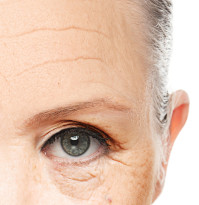
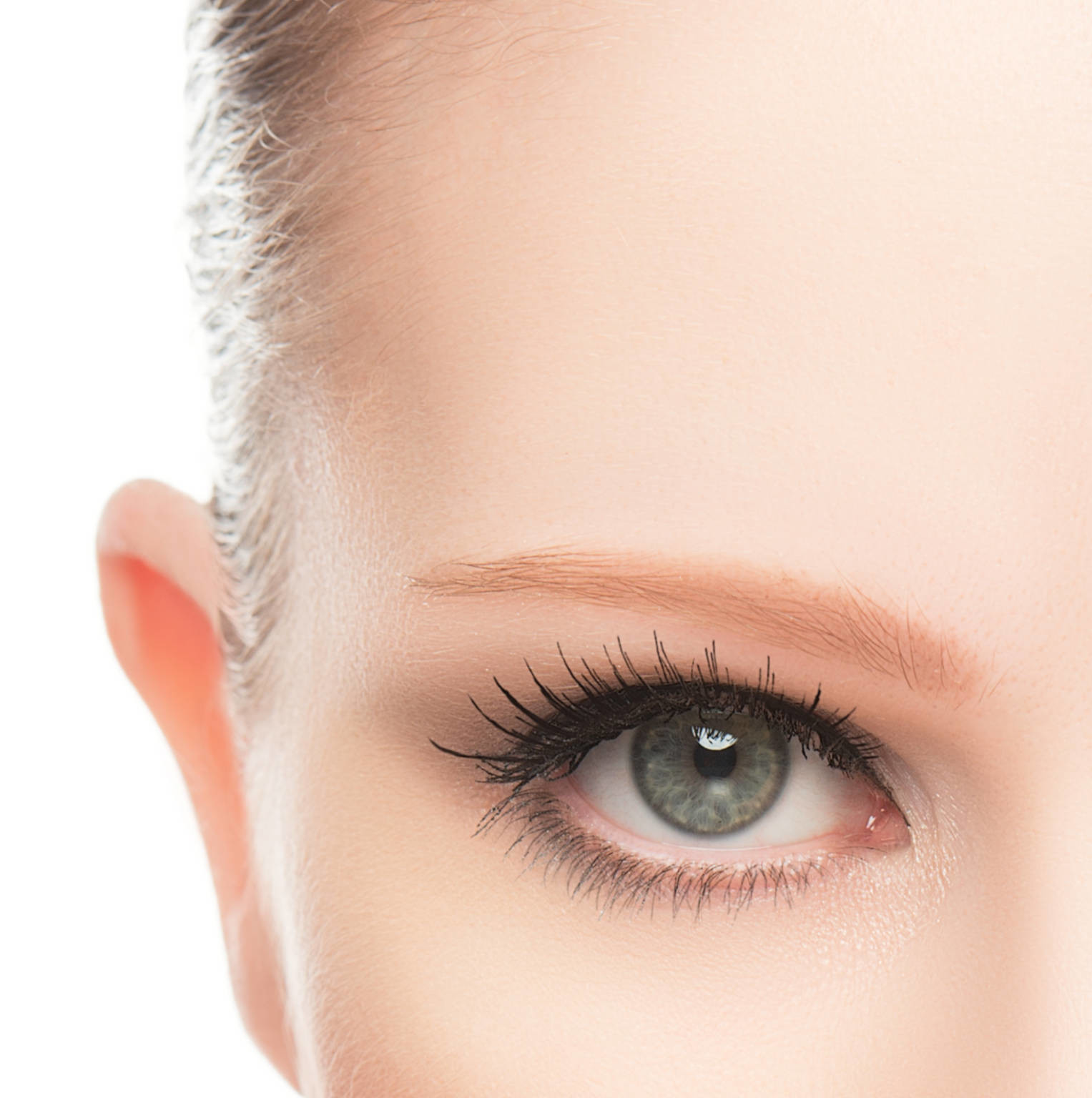
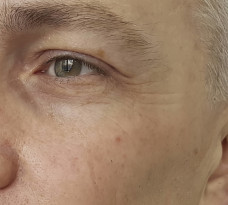
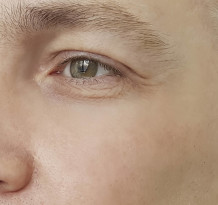
The result
The expected result, which in most case is impressive, is a combination of wrinkles decreasing with small motions enabled; it is obtained within 5 to 15 days following the injections. You can usually see the result after a few days, but for about 15 days the effects on the face may be variable (even sometimes possibly asymmetrical) before stabilizing.
The result obtained after the first session lasts 3 to 6 months averagely, after which the injections can be renewed. Depending on the patient, after several sessions, every 3 to 6 months, there might be achieved a quite stable result. Even after the second injection, the results may stay longer – 6 to 8 months, which is however quite unusual in the UAE due to heat which increases the absorption of the toxin. However, we recommend never to be re-injected within a period of less than 3 months, to avoid creating resistance to the substance, due to “a vaccination effect”. If you stop the injections, the treated muscle will go back to its normal function.
Imperfect results
In a few cases, there might be some localized imperfections, such as persistence of small wrinkles. They depend on the previous aspect of the skin, such existence of deep wrinkles. There may also exist insufficient or even asymmetrical results, related to the fact that some patients have more or less strong muscles and often asymmetrical too.
These imperfections are usually treated with a complementary botulinic toxin injection, fifteen days to a month after the injection. We must underline that if a localized complementary injection may be indicated to improve the result, it shouldn’t be done before 15 days after the session because the balance between the different muscles takes 15 days to set up.
Residual asymmetry: An asymmetry between the two sides of the face as well as more marked winkles on one side than the other may most often exist before the injection. On the other hand, the muscle responsible for the wrinkle can be stronger on one side than the other. This should be carefully estimated by the surgeon before the injection. In such a case, the injections will be performed in an adapted way, slightly differently on one side compared to the other. Nevertheless, a residual asymmetry can persist and eventually demand a complementary injection.
It should be also underlined that aesthetical procedures aim to render the patient happier, in a realistic way. But sometimes, we can miss the goal and the procedure may unfortunately aggravate pre-existing psychological problems. The post-injection experience can be extremely different from one patient to the other and this even in case of a comparable aesthetical result. Just bear in mind that botulinic toxin may easily provide rejuvenating results obtained through decreasing or even disappearing of some facial expressions, when patient’s expectations are realistic.
Possible complications
The complications are very rare. Some possible complications are the following. Facial complications may include:
- Headache: it can appear after the first injections and disappear within a few hours to a few days
- Eyebrow ptosis: frontal injection may produce a slight dropping of the eyebrows. This is generally due to a previous low position of the eyebrows. It will usually regress within a few weeks.
- Eyelid ptosis: the injection of the glabella region may induce a partial dropping of the upper eyelid which can stay for 4 to 8 weeks. This is quite rare (less than 1% of the cases) and always disappears within a few weeks.
- Smiling and swallowing discomfort: lips injection may induce a smiling discomfort or small abnormal movements. The neck injection may produce swallowing difficulties.
- Eye dryness: due to decreased tear secretion which can produce keratitis, especially on patients wearing contact lens (be aware to well hydrate the cornea).
- Paradoxical muscle contraction and mimic disturbance: in the days following injection, the muscles may present some paradoxical movements (spontaneous contraction).
General complications, although absolutely exceptional, may include:
- Allergic reaction: cutaneous rash, urticaria, general allergic reaction
- Nausea, vertigo
- Tiredness, fever, flu syndrome
- Skin and buccal dryness
My Way …. “Metron Ariston”
Carrying out any plastic surgery procedure requires profound knowledge of facial anatomy, physiology, and aesthetics, in order to obtain optimal aesthetic and functional results.
A natural face does move! I thus prefer to employ lower doses of Neuromodulators via ultra-targeted micro injections administered on specific areas of the face, as it is often more effective to under treat fine lines, and to administer touch ups periodically. This requires extensive experience and the customization of techniques in each individual face. The final result is a naturally relaxed look rather than a frozen-looking face.
This webpage aims to provide some information about the subject. Individual patient circumstances may differ, which might alter both the advice and course of therapy given to you by your doctor.
Source:
American Society of Plastic Surgeons, British Association of Plastic, Reconstructive and Aesthetic Surgeons, French Society of Plastic, Reconstructive and Aesthetic Surgery
